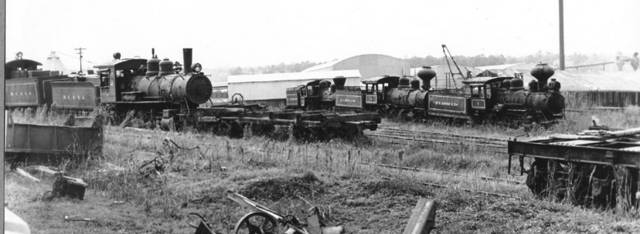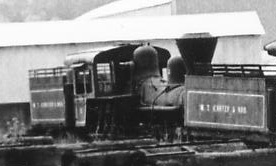I know that Shays were used by some of the logging companies in the Piney Woods of East Texas. The question is what was the fuel source toward the end of the era, say 1950 and later? I know coal was not easily available then and I’m pretty sure they were not oilers. That leaves wood and lignite (!) In many areas, especially to the north, lignite was, and still is, abundant. On the other hand, wood fired locos seem most logical.
Anybody got a good reference for this?
In 1968, I visited what I will call a locmomotive graveyard behind one of the shops of W. T. Carter Lumber Company in Camden, Texas. I saw W. T. Carter & Brother, and Moscow Camden & San Augustine locomotives. I remember seeing at least one Shay and several siderod driven locos. One or two of the locos had cabbage stacks which must have been for burning wood (and containing the sparks in a woodsy environment.) I don’t remember which one. I remember the Shay had bell-shaped wheels so it could run on logs used as track!
I have a pohoto somewhere but it’s not scanned for computer and I don’t know where it is. Maybe i can post it tomnorrow.
I visited Camdem, Texas, too in the 1960s. I no longer have any of the photos I took there, but we have several prints of MC&SA and W.T. Carter locomotives in our library file. The only Shay photos are of no. 7, built by Lima in 1907. It was a woodburner with a balloon stack. It’s long out of service in the photos, the earliest of which is probably from about 1960, and has no visible ownership lettering.
Other woodburners were W.T. Carter no. 1, a 2-6-0, and no. 5, a 4-6-0, both of which had cabbage stacks.
We have photos of seven other MC&SA and Carter locomotives, including 2-6-0, 2-8-0, and 2-8-2 types; these were all oil burners. The only action photos in the collection from the 1950s show oil-burning rod engines.
Two oil-burning rod engines were in service on the MC&SA as late as 1961 and perhaps a little later. By 1966 the road had a GE 44-ton diesel.
So long,
Andy
I looked through the “Texas” section of Michael Koch’s Steam & Thunder In The Timber (1979). The majority of the logging locomotives shown in the photo section for Texas are rod locomotives, and quite a few of them appear to be oil burners. The shays depicted in this source are:
Angelina County Lumber Co. - Angelina & Neches River RR, wood-burning, 3-truck shay with diamond stack shown at Chireno, Texas in the 1930s.
Kirby Lumber Co near Bronson, Texas had at least 25 shays. #49 (a 1905 3-truck, C/N 1621) is shown in 1941 as an oil burner. It was scrapped at Voth, Texas in 1951.
Wier Long Leaf Lumber Co. Shay #3 (a 1912 3-truck, C/N 2506) is shown in 1943 with a large Radley-Hunter spark arrester quite suitable for wood sparks, although there is no wood visible in the tender and it appears to be an oil burner.
By comparison, this source contains photographs of 1 derelict Climax and 34 rod engines in logging use in the Texas chapter. Admittedly, the shays were more likely to be out in areas less likely to be photographed, but the flatter geography of Texas likely did not mandate the shay pulling power and the distances were more favorable to a somewhat faster locomotive.
Bill
Thank you all for the specific information, on so many of the Piney Woods loggers. I was hoping that at least one logging company had experimented with lignite, although I can see why they might not have. (low BTU and messy to clean up) Maybe I’ll let my fictional Reagan Creek Lumber Company be the one to test those waters.
I finally was able to get to stored pictures from 1968.

There is a better picture of the Shay in Journal of Texas Shortline Railroads and Transportation Nov/Dec 1996 Vol.1 No.3 Entire issue is devoted to Moscow Camden and San Augustine-- 60 pages!
Here is a link to a wood burner from the W.T. Carter Bros. family of tram lines from the Piney Woods.
It is located at the Stephen F. Austin State University logging museum in Nacogdoches, Texas.
http://www.shaylocomotives.com/data/lima2399/sn-2005.htm
The narrow gauge Cedar Tap Railroad out of Lometa, TX had a 20 ton Shay.
